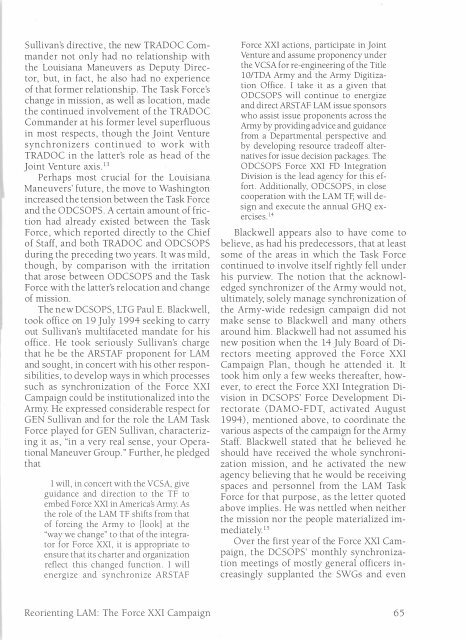The Modern Louisiana Maneuvers - US Army Center Of Military History
The Modern Louisiana Maneuvers - US Army Center Of Military History
The Modern Louisiana Maneuvers - US Army Center Of Military History
You also want an ePaper? Increase the reach of your titles
YUMPU automatically turns print PDFs into web optimized ePapers that Google loves.
Sullivan's directive, the new TRADOC Commander<br />
not only had no relationship with<br />
the <strong>Louisiana</strong> <strong>Maneuvers</strong> as Deputy Director,<br />
but, in fact, he also had no experience<br />
of that former relationship. <strong>The</strong> Task Force's<br />
change in mission, as well as location, made<br />
the continued involvement of the TRADOC<br />
Commander at his former level superfluous<br />
in most respects, though the Joint Venture<br />
synchronizers continued to work with<br />
TRADOC in the latter's role as head of the<br />
Joint Venture axis. 13<br />
Perhaps most crucial for the <strong>Louisiana</strong><br />
<strong>Maneuvers</strong>' future, the move to Washington<br />
increased the tension between the Task Force<br />
and the ODCSOPS. A certain amount of friction<br />
had already existed between the Task<br />
Force, which reported directly to the Chief<br />
of Staff, and both TRADOC and ODCSOPS<br />
during the preceding two years. It was mild,<br />
though, by comparison with the irritation<br />
that arose between ODCSOPS and the Task<br />
Force with the latter's relocation and change<br />
of mission.<br />
<strong>The</strong> new DCSOPS, LTG Paul E. Blackwell,<br />
took office on 19 July 1994 seeking to carry<br />
out Sullivan's multifaceted mandate for his<br />
office. He took seriously Sullivan's charge<br />
that he be the ARSTAF proponent for LAM<br />
and sought, in concert with his other responsibilities,<br />
to develop ways in which processes<br />
such as synchronization of the Force XXI<br />
Campaign could be institutionalized into the<br />
<strong>Army</strong>. He expressed considerable respect for<br />
GEN Sullivan and for the role the LAM Task<br />
Force played for GEN Sullivan, characterizing<br />
it as, "in a very real sense, your Operational<br />
Maneuver Group." Further, he pledged<br />
that<br />
I will, in concert with the VCSA, give<br />
gUidance and direction to the TF to<br />
embed Force XXI in America's <strong>Army</strong>. As<br />
the role of the LAM TF shifts from that<br />
of forCing the <strong>Army</strong> to [look] at the<br />
"way we change" to that of the integra<br />
tor for Force XXI , it is appropriate to<br />
ensure that its charter and organization<br />
reflect this changed function. I will<br />
energize and synchronize ARSTAF<br />
Reorienting LAM: <strong>The</strong> Force XXI Campaign<br />
Force XXI actions, participate in Joint<br />
Venture and assume proponency under<br />
the VCSA for re-engineering of the Title<br />
lOITDA <strong>Army</strong> and the <strong>Army</strong> Digitiza<br />
tion <strong>Of</strong>fice. I take it as a given that<br />
ODCSOPS will continue to energize<br />
and direct ARSTAF LAM issue sponsors<br />
who assist issue proponents across the<br />
<strong>Army</strong> by providing advice and gUidance<br />
from a Departmental perspective and<br />
by developing resource tradeoff alter<br />
natives for issue decision packages. <strong>The</strong><br />
ODCSOPS Force XXI FD Integration<br />
Division is the lead agency for this ef<br />
fort. Additionally, ODCSOPS, in close<br />
cooperation with the LAM TF, will de<br />
sign and execute the annual GHQ ex<br />
ercises.14<br />
Blackwell appears also to have come to<br />
believe, as had his predecessors , that at least<br />
some of the areas in which the Task Force<br />
continued to involve itself rightly fell under<br />
his purview. <strong>The</strong> notion that the acknowledged<br />
synchronizer of the <strong>Army</strong> would not,<br />
ultimately, solely manage synchronization of<br />
the <strong>Army</strong>-wide redesign campaign did not<br />
make sense to Blackwell and many others<br />
around him. Blackwell had not assumed his<br />
new position when the 14 July Board of Directors<br />
meeting approved the Force XXI<br />
Campaign Plan, though he attended it. It<br />
took him only a few weeks thereafter, however,<br />
to erect the Force XXI Integration Division<br />
in DCSOPS' Force Development Directorate<br />
CDAMO-FDT, activated August<br />
1994), mentioned above, to coordinate the<br />
various aspects of the campaign for the <strong>Army</strong><br />
Staff. Blackwell stated that he believed he<br />
should have received the whole synchronization<br />
mission, and he activated the new<br />
agency believing that he would be receiving<br />
spaces and personnel from the LAM Task<br />
Force for that purpose, as the letter quoted<br />
above implies. He was nettled when neither<br />
the mission nor the people materialized immediately.<br />
ls<br />
Over the first year of the Force XXI Campaign,<br />
the DCSOPS' monthly synchronization<br />
meetings of mostly general officers increasingly<br />
supplanted the SWGs and even<br />
65
















